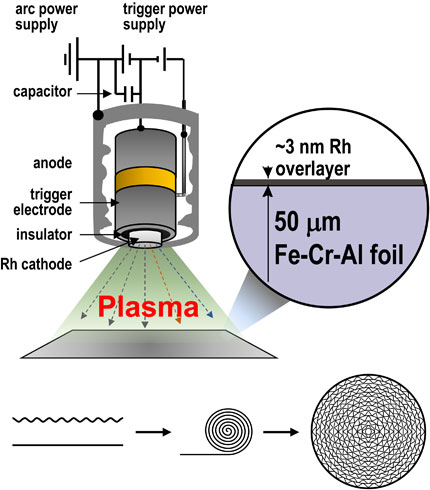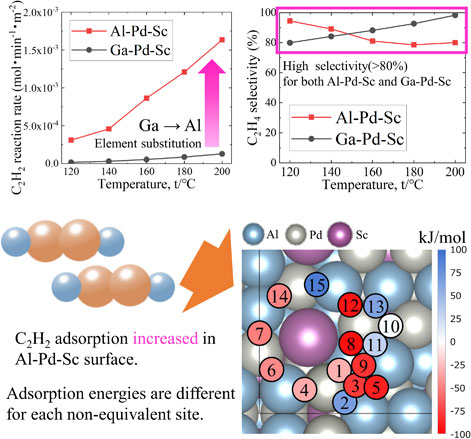64 巻, 10 号
選択された号の論文の29件中1~29を表示しています
- |<
- <
- 1
- >
- >|
Overview
-
原稿種別: Overview
2023 年64 巻10 号 p. 2337-2345
発行日: 2023/10/01
公開日: 2023/09/25
[早期公開] 公開日: 2023/08/04PDF形式でダウンロード (4415K) HTML形式で全画面表示 -
原稿種別: Overview
2023 年64 巻10 号 p. 2346-2360
発行日: 2023/10/01
公開日: 2023/09/25
[早期公開] 公開日: 2023/08/25PDF形式でダウンロード (3742K) HTML形式で全画面表示
Review
-
原稿種別: Review
2023 年64 巻10 号 p. 2361-2367
発行日: 2023/10/01
公開日: 2023/09/25
[早期公開] 公開日: 2023/08/04PDF形式でダウンロード (4752K) HTML形式で全画面表示
Special Issue on Metallurgy for Advanced Catalytic Materials
-
原稿種別: Preface
専門分野: Special Issue on Metallurgy for Advanced Catalytic Materials
2023 年64 巻10 号 p. 2368
発行日: 2023/10/01
公開日: 2023/09/25
PDF形式でダウンロード (28K) HTML形式で全画面表示 -
原稿種別: Review
専門分野: Special Issue on Metallurgy for Advanced Catalytic Materials
2023 年64 巻10 号 p. 2369-2375
発行日: 2023/10/01
公開日: 2023/09/25
[早期公開] 公開日: 2023/02/03PDF形式でダウンロード (3698K) HTML形式で全画面表示 -
原稿種別: Review
専門分野: Special Issue on Metallurgy for Advanced Catalytic Materials
2023 年64 巻10 号 p. 2376-2385
発行日: 2023/10/01
公開日: 2023/09/25
[早期公開] 公開日: 2023/01/20PDF形式でダウンロード (8550K) HTML形式で全画面表示 -
原稿種別: Review
専門分野: Special Issue on Metallurgy for Advanced Catalytic Materials
2023 年64 巻10 号 p. 2386-2393
発行日: 2023/10/01
公開日: 2023/09/25
[早期公開] 公開日: 2023/02/10PDF形式でダウンロード (4225K) HTML形式で全画面表示 -
原稿種別: Review
専門分野: Special Issue on Metallurgy for Advanced Catalytic Materials
2023 年64 巻10 号 p. 2394-2399
発行日: 2023/10/01
公開日: 2023/09/25
[早期公開] 公開日: 2023/05/19PDF形式でダウンロード (5162K) HTML形式で全画面表示 -
原稿種別: Review
専門分野: Special Issue on Metallurgy for Advanced Catalytic Materials
2023 年64 巻10 号 p. 2400-2409
発行日: 2023/10/01
公開日: 2023/09/25
PDF形式でダウンロード (2054K) HTML形式で全画面表示 -
原稿種別: Regular Article
専門分野: Special Issue on Metallurgy for Advanced Catalytic Materials
2023 年64 巻10 号 p. 2410-2416
発行日: 2023/10/01
公開日: 2023/09/25
[早期公開] 公開日: 2023/05/19PDF形式でダウンロード (2786K) HTML形式で全画面表示 -
原稿種別: Regular Article
専門分野: Special Issue on Metallurgy for Advanced Catalytic Materials
2023 年64 巻10 号 p. 2417-2424
発行日: 2023/10/01
公開日: 2023/09/25
PDF形式でダウンロード (5721K) HTML形式で全画面表示 -
原稿種別: Regular Article
専門分野: Special Issue on Metallurgy for Advanced Catalytic Materials
2023 年64 巻10 号 p. 2425-2430
発行日: 2023/10/01
公開日: 2023/09/25
[早期公開] 公開日: 2023/06/16PDF形式でダウンロード (2369K) HTML形式で全画面表示 -
 原稿種別: Regular Article
原稿種別: Regular Article
専門分野: Special Issue on Metallurgy for Advanced Catalytic Materials
2023 年64 巻10 号 p. 2431-2439
発行日: 2023/10/01
公開日: 2023/09/25
-
原稿種別: Regular Article
専門分野: Special Issue on Metallurgy for Advanced Catalytic Materials
2023 年64 巻10 号 p. 2440-2444
発行日: 2023/10/01
公開日: 2023/09/25
[早期公開] 公開日: 2023/06/30PDF形式でダウンロード (834K) HTML形式で全画面表示 -
Metal-Support Interaction at Palladium-Composite Manganese Oxide Interface and CO Oxidation Activity原稿種別: Regular Article
専門分野: Special Issue on Metallurgy for Advanced Catalytic Materials
2023 年64 巻10 号 p. 2445-2449
発行日: 2023/10/01
公開日: 2023/09/25
PDF形式でダウンロード (3609K) HTML形式で全画面表示
Regular Article
Materials Physics
-
原稿種別: Regular Article
2023 年64 巻10 号 p. 2450-2456
発行日: 2023/10/01
公開日: 2023/09/25
PDF形式でダウンロード (3932K) HTML形式で全画面表示
Microstructure of Materials
-
原稿種別: Regular Article
2023 年64 巻10 号 p. 2457-2465
発行日: 2023/10/01
公開日: 2023/09/25
PDF形式でダウンロード (7347K) HTML形式で全画面表示
Mechanics of Materials
-
原稿種別: Regular Article
2023 年64 巻10 号 p. 2466-2470
発行日: 2023/10/01
公開日: 2023/09/25
PDF形式でダウンロード (1636K) HTML形式で全画面表示 -
原稿種別: Regular Article
2023 年64 巻10 号 p. 2471-2480
発行日: 2023/10/01
公開日: 2023/09/25
[早期公開] 公開日: 2023/07/21PDF形式でダウンロード (4004K) HTML形式で全画面表示 -
 原稿種別: Regular Article
原稿種別: Regular Article
2023 年64 巻10 号 p. 2481-2488
発行日: 2023/10/01
公開日: 2023/09/25
-
原稿種別: Regular Article
2023 年64 巻10 号 p. 2489-2495
発行日: 2023/10/01
公開日: 2023/09/25
[早期公開] 公開日: 2023/08/18PDF形式でダウンロード (1835K) HTML形式で全画面表示
Materials Chemistry
-
原稿種別: Regular Article
2023 年64 巻10 号 p. 2496-2502
発行日: 2023/10/01
公開日: 2023/09/25
PDF形式でダウンロード (4753K) HTML形式で全画面表示 -
原稿種別: Regular Article
2023 年64 巻10 号 p. 2503-2507
発行日: 2023/10/01
公開日: 2023/09/25
PDF形式でダウンロード (986K) HTML形式で全画面表示
Materials Processing
-
原稿種別: Regular Article
2023 年64 巻10 号 p. 2508-2514
発行日: 2023/10/01
公開日: 2023/09/25
PDF形式でダウンロード (4226K) HTML形式で全画面表示 -
原稿種別: Regular Article
2023 年64 巻10 号 p. 2515-2522
発行日: 2023/10/01
公開日: 2023/09/25
PDF形式でダウンロード (4738K) HTML形式で全画面表示
Engineering Materials and Their Applications
-
原稿種別: Regular Article
2023 年64 巻10 号 p. 2523-2529
発行日: 2023/10/01
公開日: 2023/09/25
[早期公開] 公開日: 2023/07/21PDF形式でダウンロード (4035K) HTML形式で全画面表示 -
原稿種別: Regular Article
2023 年64 巻10 号 p. 2530-2534
発行日: 2023/10/01
公開日: 2023/09/25
[早期公開] 公開日: 2023/07/28PDF形式でダウンロード (1437K) HTML形式で全画面表示 -
原稿種別: Regular Article
2023 年64 巻10 号 p. 2535-2541
発行日: 2023/10/01
公開日: 2023/09/25
PDF形式でダウンロード (2784K) HTML形式で全画面表示
Current Trends in Research
-
原稿種別: Current Trends in Research
2023 年64 巻10 号 p. 2542-2546
発行日: 2023/10/01
公開日: 2023/09/25
[早期公開] 公開日: 2023/07/28PDF形式でダウンロード (2402K) HTML形式で全画面表示
- |<
- <
- 1
- >
- >|


























